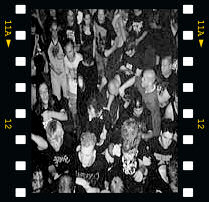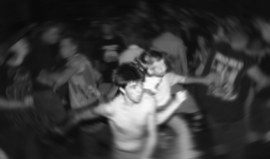 No, not A Year of Songs… this scene is probably more like a fair beauty cast under a wicked spell waiting for her prince to plant a big fat smacker on her pale lips… or maybe more like an irascible old bear at the ragged end of hibernation, hearing the chirping of spring birds and putting his big old furry paws over his ears and trying to go back to sleep.
No, not A Year of Songs… this scene is probably more like a fair beauty cast under a wicked spell waiting for her prince to plant a big fat smacker on her pale lips… or maybe more like an irascible old bear at the ragged end of hibernation, hearing the chirping of spring birds and putting his big old furry paws over his ears and trying to go back to sleep.
The scene to which the song refers is the virtualized songwriting workshop I participate in on a popular musician’s website which has became the victim of its own success when its once high search engine ratings increasingly made it a target of robotic spam assaults, assaults that ended up dragging down the servers and bringing the massive site to its virtual knees.
Dire portrait painted, however, let me rush to assure the reader that the reference is ironic. The first line of the song was taken from the title of a thread in the new forum, a result of a massive effort to move hundreds of millions of bulletin board posts, user reviews, and blog articles to new servers run by a shiny, big-player customer service outfit that runs customer support and social media bulletin board/forum software for a number of Fortune 500 joints.
The regulars in the Songwriting Workshop are sensitive artist types, for sure, but they’re also self-reliant. When the old forum software ground to a near halt, forum regulars set out on their own to create a temporary forum using free forum software.
Now we’re all more or less back at the old/new site… dazzled and occasionally bewildered by gleaming but unfamiliar virtual surroundings. But, you know, we’re resilient, too. We’ll make it.
But that Sad that it’s so dead in here thread title kept bouncing up in the listings as folks would comment, commiserate, or crack wise and — with the first days of the RPM Challenge weighing on me, desperation begat the slightest hint of inspiration. (And, yes, much perspiration was subsequently required.)
Oh, wait, I hear you gentle readers murmur. WTF is this RPM Challenge?
That would be this: Every February the RPM Challenge goes out to songwriters to try to create an album of music in 28 days, hopefully doing everything from writing to recording and mixing in time to pop a CD in the mail by noon on March 1st. (And, yes, you can jump in at any time in February. If you approach this stuff the way I approached term papers in my long lost academic life, you will probably be hitting the big red button about 9 am on the 28th of Feb.)
Anyhow, backstory laid out, excuses made, rationales aired, let’s move on to the song at hand…
Longtime readers of this blog may recall my nostalgic rhapsodizing on those magical years at the beginning of the punk rock era we like to call The Late Seventies.
I first chopped off my hair — which had been nearly waist-length — back in ’73. I had been at a concert for one of my favorite bands, the arty, intelligent, jazzy Traffic. As I waited to get in, I looked around me. The others had long hair, freak clothes… they didn’t look much different than me, really.
There had been a time in the late 60s when just having long hair seemed like a badge of being interesting, iconoclastic, outsider.
But by ’73, at least half of the people I saw with long hair I was running into appeared very much to be leaden brained dolts who couldn’t bother to try to find two neurons to rub together. Two days later, three feet of hair became two inches. Suddenly, cops had longer hair. I felt a bit like I’d just arrived on the planet.
When Patty Smith’s Horses album came out, with the title song’s harrowingly visceral, yet poetically surreal account of a brutal high school attack, I knew it was finally on, the change was coming any day. The new era had arrived.
While the signs of new music were around in ’75 when I started prowling the new, small, sometimes underground clubs where music biz outsiders played, the LA punk scene didn’t really blow up until late ’77.
Blow up, perhaps, being a relativistic term.
By my count, there were maybe 50, full-on, hard-core, can’t walk down the street without folks staring and pointing punk rockers in LA — and maybe another 200 folks who were more like me, short haired, non-hippy, non-disco, somewhat disaffected types. A lot of that cohort probably looked a lot like rock writers of the era… glasses, dark sport coats, skinny jeans, dark t-shirts or white shirts buttoned to the collar and/or worn with the soon-to-be-totally annoying skinny ties that looked so cool for such a short time.
The scene was magical.
Really.
Okay, sure, some of the clubs stank. Literally. Toilets regularly overflowed at the divey venues and overburdened, blackmarket warehouses-turned-nightclubs. Bouncers were often jocks or thugs who often appeared to think the clientele were sissies from Mars. And, for sure, it was an arty, boho, largely anti-macho crowd in those early days.
That would change as wannabe bands like The Cars, The Police, as well as bands that had once been part of the punk scene like Devo and the Dickies began to draw in new elements, specifically suburban dudes, jocks, and frat boys who turned the once-relatively friendly/benign ‘pogo pit’ into the ‘slam pit.’ Moshing, as it was originally known in the UK, took a particularly ugly turn in the 80s as that cohort met and didn’t always mix well with old school hardcore punks. And a half.
By late ’78, it seemed to me and my pals down in Long Beach that maybe the LA punk scene that had seemed so vibrant just a year before might be dying. I remember telling a bunch of pals from a couple of bands who were having a strategizing/commiserating jawbone session, “Let me be the first to say, punk rock is dead.”
I reminded them that the Haight-Ashbury hippies had held a “Funeral for the Hippie” in 1968 and that, though hippie attire and trappings grew in popularity with the mainstream, the real core of the hippie movement was pretty well dead by the 70s, even as the look became a costume for much of middle America.
Of course, punk rock didn’t die in ’78.
But something did.
Punk rock, the commercial genre, though, barreled on, going from the wildly divergent outsider music of the late 70s to the highly formulaic, tightly conformist, cliche-driven cookie cutter crap of the 80s and the pop punk pre-gurgitations of the 90s — in near perfect parallel to the emergence of mall rat chain stores filled with racks of identical “punk outfits” — just add glory spikes and purple hair dye.
That out of the way, here is my first recorded lyrical effort from my one-man assault on the RPM Challenge…
Sad that it’s so dead in here
sad to see the flocks have fled
sad to say its inevitable
but some things must be said
This scene is dead
the scene is dead
the reasons are many
excuses are few
this scene is dead
the scene is dead
God knows the scene is dead
We were so cool
so beautiful
so free so hip
the people to be
What we had is gone, what we did is done
the songs we sang as good as never sung
This scene is dead
the scene is dead
God knows the scene is dead
Came back to see what had become
of the place where so much was said and done
footprints in the dust
shadows in a mirror
was it yesterday
or a thousand years
This scene is dead
the scene is dead
the reasons are many
excuses are few
This scene is dead
the scene is dead
God knows the scene is dead
this scene is dead
the scene is dead
ooohoooh oohoooh
oohooh oohooh
this scene is dead
the scene is dead
God knows the scene is dead



